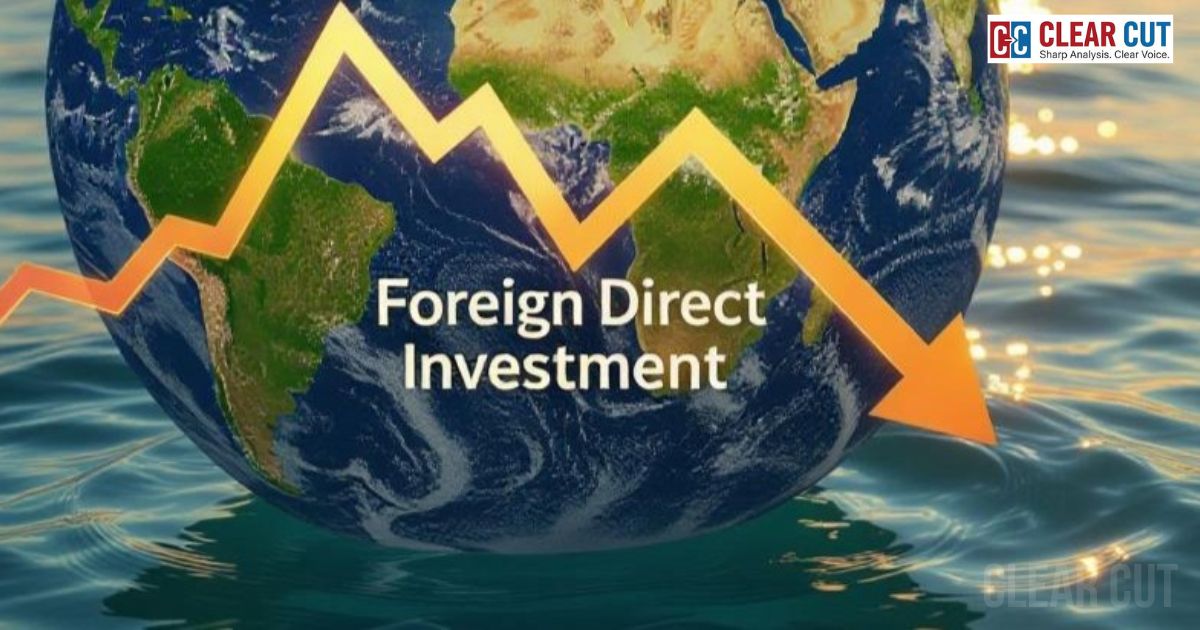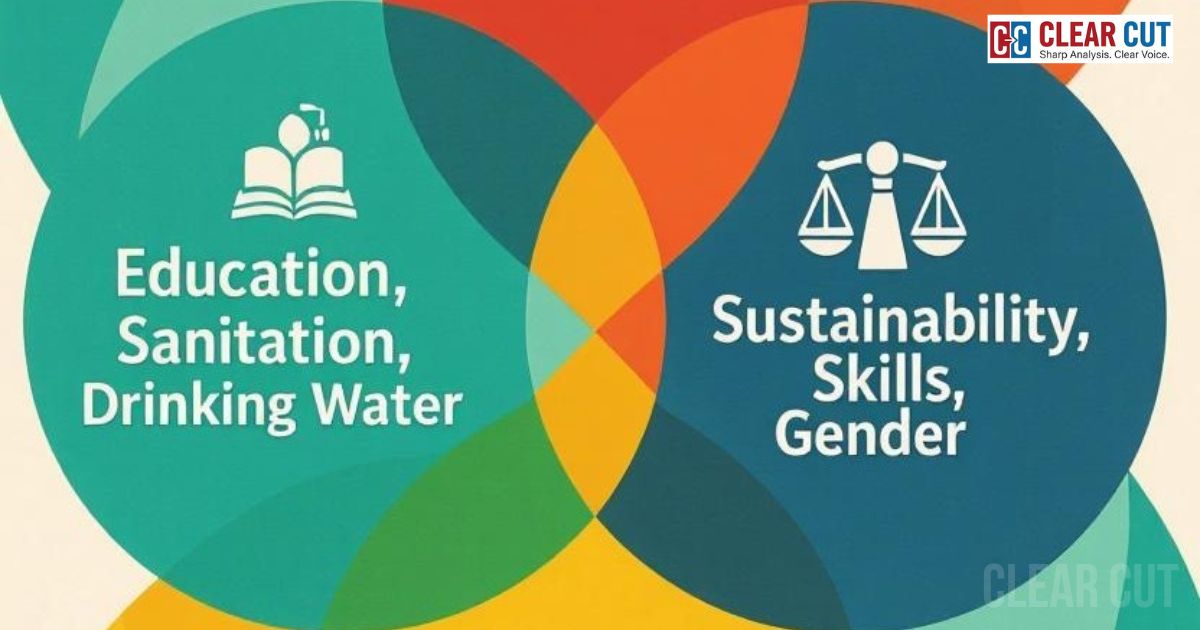Photo Credit: Antara Mrinal
Clear Cut Livelihood Desk
New Delhi, UPDATED: Sep 30, 2025 02:55 IST
Written By: Antara Mrinal
For a long time now, Foreign Direct Investment (FDI) has been a bellwether of global economic confidence, demonstrating how much businesses are willing to expand, innovate, and take risks across borders. Unfortunately, as detailed in the United Nations Conference on Trade and Development (UNCTAD) World Investment Report 2025, the world has entered an era of retreat. In 2024, global FDI dropped by 11%, falling to US$1.5 trillion, marking the second year of consecutive decreases. This does not just represent a datum in a report, it represents the precarious nature of globalization and the increasingly complex reality facing policymakers, businesses, and developing economies.
Developed economies, especially Europe, experienced a 12% decline in inflows as high interest rates and regulatory scrutiny weakened cross-border mergers and acquisitions. Developing economies experienced a somewhat better fate, however, Africa and least developed countries (LDC) were hardly participants, raising major concerns about the capacity of these countries to finance the Sustainable Development Goals (SDGs). Even Asia, for a time the world leader in FDI, flattened growth, while China and India continued to attract FDI. A further decline in greenfield investment announcements by 8% likely indicates that a slowdown will be seen in 2025, which may threaten job creation and growth, especially in developing areas.
FDI Inflow Trend
Developed economies experienced a decline in FDI inflows by 22%, with Europe being hard hit, especially Germany, which saw a dramatic 89% drop. In North America, however, the trend reversed with a 23% increase, led by the United States. In spite of an overall modest decline of 3% in developing Asia, it continued to be the largest recipient of FDI. Southeast Asia, particularly, recorded significant growth, up by 10% to $225 billion, its second highest level on record. Africa recorded FDI inflows rising an astonishing 75%, mostly influenced by a major project in Egypt. Excluding that particular project, FDI inflows rose 12% as a result of both investment facilitation and cost effective regulatory reforms. Latin America and the Caribbean saw a total of 12% decrease in total FDI flows.
Similarly the Middle East continued to steadily attract strong inflows, driven mainly by the ongoing economic diversification plans of the Gulf countries. Among vulnerable economies, least developed countries (LDCs) grew by 9% to $37 billion of FDI flows making up 2.4% of global flows, small island developing states (SIDS) grew by 11% and landlocked developing countries (LLDCs) decreased by 10%. These data points illustrate the unequal distribution of global FDI flows, which creates opportunities for emerging regions, but emphasizes the portentous need for investment attraction policies and investment retention policies mostly on developing and vulnerable economies.
| Economic Grouping and Region | 2024 (Billions of USD) | 2023 (Billions of USD) | Percentage Change |
| World | 1,493 | 1,673 | -11% |
| Developed economies | 626 | 807 | -22% |
| Europe | 182 | 439 | -58% |
| North America | 343 | 280 | +23% |
| Developing economies | 867 | 865 | +0.2% |
| Africa | 97 | 55 | +75% |
| Latin America and the Caribbean | 164 | 187 | -12% |
| Asia | 605 | 622 | -3% |
Structural Shifts Reshaping Investment
This global reversal can be attributed to a number of structural factors. Higher interest rates have contributed to greater risk aversion among investors, who are choosing to invest domestically rather than abroad. Additional post-COVID-19 supply chain changes, geopolitical tensions, and friend-shoring are reducing capital flows to politically sensitive economies. The concentration of advanced economy hyped technologies like semiconductors, AI, and clean technologies has also channeled FDI into a small number of high tech centres. Climate finance gaps are also exacerbating the situation. While sustainability-themed investments have skyrocketed, actual FDI levels into renewable energy and green infrastructure are only a fraction of the levels needed to meet global climate goals. Overall, the global investment landscape is becoming bifurcated: major economies such as the United States, China, and India are attracting massively disproportionate levels of investment while economically vulnerable regions such as Africa and LDCs are being left behind.
Impact on India’s CSR Ecosystem
The slowdown in the global economy has significant implications for India’s corporate social responsibility (CSR) environment. Under India’s Companies Act of 2013, large companies are required to spend 2% of their average profits over the previous three years on CSR initiatives. Foreign firms and their Indian affiliates can account for a large portion of this funding. A decrease in global foreign direct investment (FDI) means fewer new international firms will enter India or expand aggressively, shrinking the number of firms available to support CSR funding. Fewer new firms will affect CSR funding abilities, while lower profits for companies focused on FDI means a reduced CSR funding requirement, limiting the ability to fund robust social initiatives.
At a greater level, risk-averse behavior among multinational investors will also change the CSR focus from priority social initiatives into compliance-based initiatives, focusing on education and health services as opposed to potentially transformative projects like climate change adaptation or tech-enabled programs. This is an issue of some importance in states like Maharashtra, Karnataka, Tamil Nadu, and Gujarat where new projects on the part of foreign companies serve as the funding mechanism for skilling initiatives, renewable energy microgrids, and other transformative projects.
Green Transition and Sustainability Challenges
The decline in greenfield investment will likely dampen the degree to which India will transition to green. As foreign companies increasingly attach their corporate social responsibility (CSR) spending to environmental, social, and governance (ESG) pledges to support renewable energy adoption, waste management, and climate resilience projects, foreign direct investment (FDI) in greenfield projects fell off in 2024, raising concerns that sustainability-aligned projects will be further delayed or decreased in scope in line with the fall in greenfield FDI.
India’s position is, however, relatively agile. In 2024, India saw about US$60 billion of FDI related to digital services and renewable energy. This flow will provide continued momentum for firms to innovate relationships with CSR to the corporate purpose for firms invested in India. The state of domestic corporate profitability across the economy in core sectors, such as property and technology, remains fairly strong, which means that domestic corporations can continue to allocate their CSR spend toward education, healthcare, and environmental programming. In FY 2023 – 24, India saw a CSR spend of ₹25,000 crore (approximatelyUS$3 billion) and education and healthcare as the core focus of domestic CSR spend, while environmental programs also gained traction. Efforts were occurring between domestic corporations and the government to align CSR spends with the sustainable development goals (SDGs) of the UN with an eye on the climate, gender equality, and employment preparation and development, as well.
Challenges and Opportunities
A protracted worldwide FDI slowdown may create shifts in CSR configurations in India. Larger local firms such as Reliance, TCS, Infosys, and ITC may experience more emphasis on their responsibility for implementing social and environmental programs at scale while foreign companies carry with their CSR strategies to smaller, more cost-effective approaches. At the same time, India’s growing impact investment ecosystem, expected to reach US$14 billion by 2030, promises a viable pathway to supplement traditional CSR funding streams and buffer against inactivity in pivotal social initiatives. Broadly, the contraction of global FDI is a challenge and an opportunity. While it reiterates the precariousness of cross-border capital flows, it equally invites India to strengthen domestic mechanisms, rethink CSR strategies, and utilize impact investments so that progress in social and environmental impact persists, even as global capital becomes more selective.




